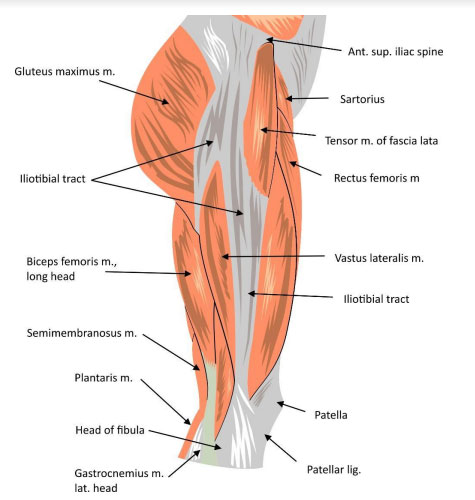Pelvic apophyseal avulsion fractures occur in younger athletes.
Causes
● A pelvic apophyseal avulsion fracture is caused by the sudden and forceful contraction or passive lengthening of the muscles involved during acceleration and deceleration of the body as seen in a jump or a kick. This injury is associated with playing soccer, football, gymnastics, basketball, and baseball.
Symptoms
● Injured athletes will present with an acute onset of localized pain that is exacerbated by passive or active stretching of the involved muscles.
● Pelvic apophyseal avulsion fractures rarely manifest during direct trauma or while muscles are being overused.
● The rectus femoris insertion at the anterior inferior iliac spine, the sartorius insertion at the anterior superior, iliac spine, the hamstring insertion at the ischial tuberosity, the tensor fascia lata on the iliac crest, and the rectus abdominis insertion on the superior corner at the pubic symphysis are the main muscles involved in this injury.
o Pelvic apophyseal avulsion fractures are often misdiagnosed as a muscle strain leading to ineffective treatment and delaying the return to sports.
Treatment
● If you experience any of the signs and symptoms listed above, please consult with a local Dallas-Fort Worth, Texas physician or general practitioner for a physical assessment, imaging (X rays, magnetic resonance imaging (MRI), or a possible computer tomography (CT) scan), and a possible orthopedic consult.
● The fracture is best managed with rest and ice, followed by intermittent weight bearing with crutches until symptoms improve.
● Patients may progress to light stretching and full weight bearing as tolerated with a slow return to sports once strength has returned.
● If this non-surgical treatment is not effective, then surgery may be needed.
● Research has shown that the overall success and return to sports is higher in patients receiving surgery.

References
Calderazzi, F., Nosenzo, A., Galavotti, C., Menozzi, M., Pogliacomi, F., & Ceccarelli, F. (2018). Apophyseal
avulsion fractures of the pelvis. A review. Acta bio-medica : Atenei Parmensis, 89(4), 470–476. https://doi.org/10.23750/abm.v89i4.7632
Eberbach, H., Hohloch, L., Feucht, M. J., Konstantinidis, L., Südkamp, N. P., & Zwingmann, J. (2017). Operative versus conservative treatment of apophyseal avulsion fractures of the pelvis in the adolescents: a systematical review with meta-analysis of clinical outcome and return to sports. BMC musculoskeletal disorders, 18(1), 162. https://doi.org/10.1186/s12891-017-1527-z
Kleweno, C. P., Scolaro, J., Sciadini, M. F., McAlister, I., Shannon, S. F., & Chip Routt, M. L. (2020). Management of Pelvic Fractures. Instructional course lectures, 69, 489–506
Nelar. (2021). [Illustration]. Hip musculature anatomy. https://www.shutterstock.com/image-vector/hip-musculature-anatomy-369667304
